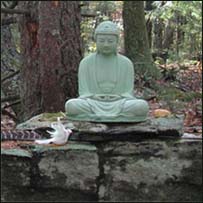|
|
 |

|

|

|
The greatest gift is the
gift of the teachings
|
|

|
| |
|
Dharma Talks
|
2023-02-18
About A Bout o' Doubt
1:24:34
|
|
Nathan Glyde
|
|
|
The hindrances are essential to notice, and to question, to gently challenge their view. Doubt is one of the most pernicious hindrances: anytime we consider stopping or not starting our practice, it is doubt declaring confidently: "there is nothing here for you, no liberation, no beauty, no meaningfulness". But there is! Guided meditation, and Dharma reflection, with just the answer to some questions at the end.
|
|
Gaia House
:
Online Dharma Hall - Feb 2023
|
|
|
2022-10-14
Meditation on the arising of desire, Dhamma talk Part 4 on Satipaṭṭhāna: Principles (dhammā)
1:27:36
|
|
Bhante Sujato
|
|
|
Meditation on the arising of desire, the drivers of thought rather than getting caught in thought. Dhamma talk Part 4 on Satipaṭṭhāna: Principles (dhammā). The 5 hindrances and 7 awakening factors common to all versions of Satipaṭṭhāna. The novelty of this section builds on the previous sections and introduces causality; where the arising of things like desire come from, as well as how they come to end, and how they don't arise again using both observation and inference. Dhamma as natural principles that describe how the world works.
|
|
Lokanta Vihara
|
|
|
2022-07-07
Working with Hindrances to Mettā Meditation (Retreat at Spirit Rock)
49:25
|
|
Tempel Smith
|
|
|
As we practice mettā meditation we will have waves where the practice feels easy, intuitive and validating; and we will all have waves where we struggle. There are five very common states which visit us in meditation practice called the "five hindrances". These are commonly named in English as craving, aversion, dullness, restlessness, and doubt. For steady mettā practice our first response to these challenges is to practice more carefully with patience determination. The second response is to offer ourselves kindness and compassion during challenging times. For mettā meditation and for the other three brahmaviharas, our third response to challenging times is to turn wakefully towards the qualities of the challenge and see them as only temporary conditions. We can greatly reduce the experience of suffering in the hindrances when we have mindful experience of them.
|
|
Spirit Rock Meditation Center
:
July Lovingkindness Retreat
|
|
|
2022-04-12
Beyond Distraction: Five Practical Ways to Free the Mind
29:30
|
|
Shaila Catherine
|
|
|
On the occasion of the publication of her third book, Beyond Distraction: Five Practical Ways to Free the Mind, Shaila Catherine shares a progressive series of strategies to overcome the hindrances of restlessness, obsessive thinking, and rumination; dispel thoughts of anger, hatred, and anxiety; and curb habitual distractions. By freeing the mind from the fetter of restlessness, meditators can calm their minds, develop tranquility, strengthen concentration, create the conditions for jhana, comprehend the nature of the mind, experience emptiness, and incline the mind toward liberating insight and nibbana. These teachings are based on two suttas (19 and 20) in the Middle Length Discourses of the Buddha.
|
|
Insight Meditation South Bay - Silicon Valley
|
|
|
2021-12-12
At the Frontier of Harmlessness – Chop Off the Head of Mara
42:13
|
|
Ayya Medhanandi
|
|
|
One who practices true compassion inwardly as well as to others is praised as a superior person, a spiritual warrior on the path of harmlessness. How do we emulate that? Guided by right intention, we abandon the hindrances of the mind and patiently whittle away our ingrained habit of ego construction. We learn to see wisely and to forgive conditions as we journey to transcendence.
|
|
Portland Friends of the Dhamma
:
Full Catastrophe Compassion
|
|
|
2021-11-24
Q&A
34:29
|
|
Ajahn Sucitto
|
|
|
00:11 Feeling dizzy with QiGong; 00:49 Difference between calming mental activity and calming mind; 14:33 How to calm bodily activities with searing bodily pain; 16:29 Do we work sequentially on calming mental, then bodily formations, or together; 18:09 Examples of ‘accept not adopt’ particularly around past trauma; 21:04 Q6 When the hindrances calm down, what else is there to be found as citta saṇkhāra? 22:56 What does vicāra mean; 26:09 In-breath is short and painful when trying to elongate; 28:25 Should I try to smooth out bumpy breathing; 30:18 Meditative experience in terms of this social existence.
|
|
Bodhi College
:
Breathing to Liberation (Ānāpāṇasati)
|
|
|
2021-08-07
Q&A
47:26
|
|
Ajahn Sucitto
|
|
|
Q1- How to deal with strong floods of sankhāra, in dealing with my role and identity as a Mother. Q2 – Are the qualities of the heart conditioned in the same way as intellectual abilities or physical strength. Q3 – I have a 17 year old dying cat. She suffers a lot and rejects the comforting medicine of the vet. Is this cat wisdom? Q4 What would be a sequence for a daily meditation practice? Q5 Are dharma and dhamma the same? Q6 Can we use the 5 indriyas to solve the 5 hindrances? Q7 How to deal with a band of pain around the back. Q8 Healthy attachment is important for example in childhood development. How do we know if it is OK to have an attachment or not.
|
|
Sunyata Buddhist Centre
:
Open Stability
|
|
|
|
|